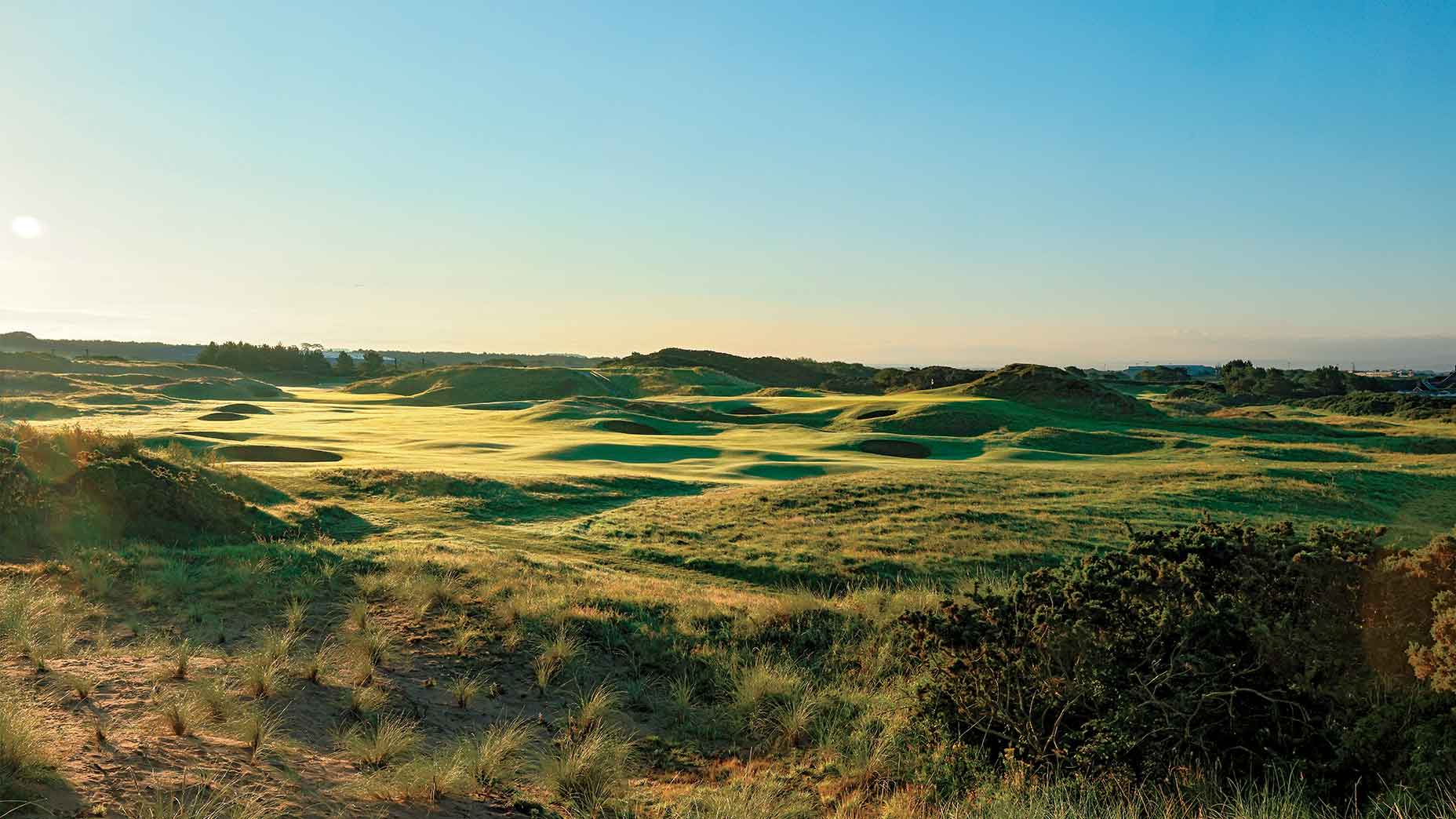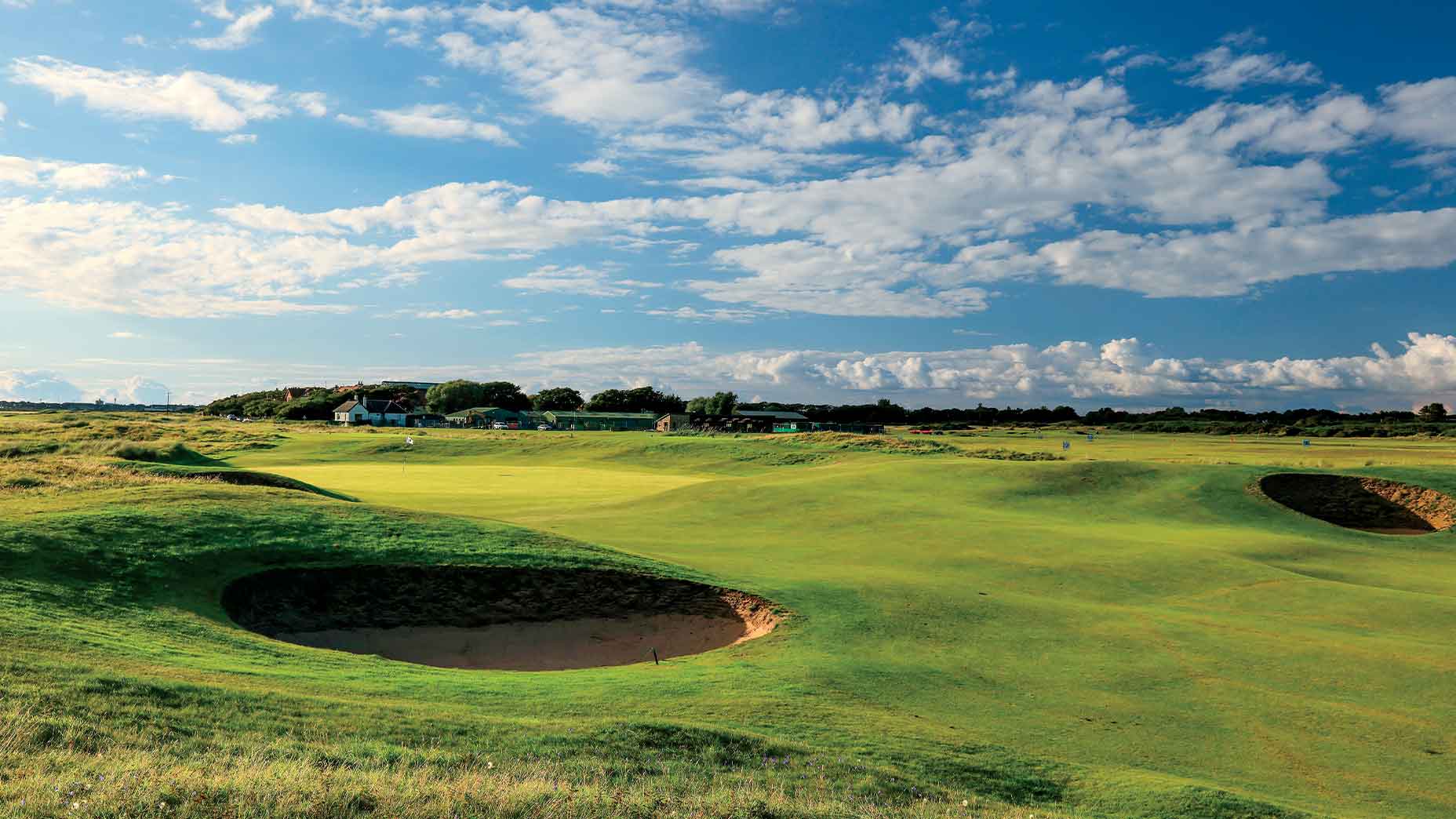The 18th hole at Royal Troon Golf Club in Scotland.
Getty Images/David Cannon
Though its legend is often linked to one of the game’s most beguiling short par 3s, Royal Troon has a not-often-enough-savored secret sauce: its collection of tasty and testy “two-shotters.” Architecture Editor Ran Morrissett explains.
If you’re a golfer — and let’s assume, as a reader of GOLF.com, that you are — you likely know plenty about the Postage Stamp on the Old Course at Scotland’s Royal Troon. The 123-yard 8th hole is one of the game’s most iconic and daunting short par 3s, placed in the same exalted class as the 17th at Sawgrass, the 12th at Augusta National and the 7th at Pebble Beach. The only way the Postage Stamp, with its vexing shelf green and five surrounding bunkers, could be more nerve-racking or competitively consequential is if it delivered its drama in the last few holes of a round, not on the front nine.

Gary Lisbon
But historic Royal Troon isn’t hosting its 10th Open Championship on the strength of just one hole, nor on the much-discussed fact that the Old Course now features both the shortest hole (the Postage Stamp) and the longest hole (the par-5 6th, lengthened to 623 yards for this championship) on the Open rota. No, what lends Royal Troon its reliable grit and thrills is something less heralded: its remarkable collection of par-4 holes and the unique pacing they lend to the classic out-and-back routing first crafted by architect Willie Fernie in 1887.
The last time the world’s best golfers congregated here, in 2016, Troon inspired one of the greatest two-man battles in the sport’s long history when Henrik Stenson barely edged a fiery, 46-year-old Phil Mickelson, leveling his fatal blow with a 50-foot bomb across the green of the par-4 15th. Do the par 4s add up to more than usual at Troon? They do. Let’s take a look at how they roll out on the course.
Holes 1 through 3 — each of them a par 4 — run in a southerly direction, with the Firth of Clyde hard along the right.
None of them exceed 400 yards, making, theoretically, for a gentle handshake of a start. But the holes are liberally bunkered, and making a mess of them is a real possibility. The pressure not to do so is acute, as this is the course’s easiest three-hole stretch. Get off to a slow start and no one fancies your chance of a rebound.

Getty Images/David Cannon
The next par 4 comes at the 7th and it’s all-world, even if its light is dimmed a bit by its close proximity to the Postage Stamp. It’s surely one of golf’s great links holes, yet it doesn’t begin to get the attention it deserves.
Heading inland, away from the Firth of Clyde, the 7th might lead you to think that a letdown is coming. Far from it. The hole, a dogleg, swings right into some of the course’s finest dunes. In fact, Tel-El-Kebir (named after an 1882 battle in the Sudan that, culturally, was front of mind when Fernie created the hole) may be even better today than a century ago.
At just over 400 yards, the hole might entice big hitters to lash a power fade and, with a coastal breeze behind them, drive the green. But miss it straight and you can end up in 15-foot-high dunes; or, cut it just a bit too much and your hopes will perish in a steep bunker 30 yards short and right of the green.
How quickly can the hunter become the hunted on hole No. 7? Real quick. For that reason, over the course of four days, you might see everything from a mid-iron to a driver used off the tee. That’s a hallmark of the greatness of Troon’s design: Golfers don’t robotically pull driver on every tee. Based on the day’s playing conditions, constant thinking and rethinking is required, which helps explain why Troon members never tire of playing the course.
The 9th and 10th holes are a robust pair of two-shotters that head into the biggest dunes on the property. They both feature approach shots to elevated greens that shrug off indifferently struck balls. The roly-poly 9th fairway culminates at a green on Troon’s south end, and the 10th begins the journey back north to the clubhouse. Named Sandhills, the 10th, which plays up and over a big dune to a hidden fairway, involves a particularly nervy tee shot. Complicating matters, the prevailing wind is frequently into you on the inward nine. The kindness initially extended by the course’s first three holes? It’s a distant memory.
Standing on the 11th tee, a certain discomfort takes hold. History has shown that this 498-yarder is not only the hardest par 4 at Royal Troon but also one of the hardest in world golf. Its fairway runs parallel to a rail line — thus the hole’s indelible name, the Railway — which comes within a mere six paces of the green. Ideally, a tee shot down the right provides the best angle for the long approach to its open green. If you steer left off the tee and away from the tracks, the second shot becomes more complex, as a pit bunker guards the left front of the green. It’s a scary hole made more so by the knowledge that even the mighty Jack Nicklaus once posted a 10 there.

David Cannon/Getty Images
Troon’s dogleg-right 12th turns toward the Firth and provides a respite from the march to the north, ending at a green beautifully framed at the base of a dune. Members sometimes refer to the course as a three-act play. The first six holes get you into the round as you travel along the coast. The next six, which end at the 12th and occupy the property’s southern end, are set in the biggest dunes. That leaves the final act: Troon’s famously bruising six-hole finish.
It begins with the bunkerless, 473-yard 13th. Indeed, though holes 10 through 13 span 1,870-plus yards, they feature a mere three bunkers total, which speaks to the dynamic golf terrain they occupy. After all, artificial hazards (aka bunkers) are needed to spruce things up only when Mother Nature doesn’t get the job done. No such worries here. Hole 13’s rumpled ground is nothing short of ideal. Indeed, because of the unpredictability of the tee shot’s first bounce and run out, the hole can be a nightmare for even the world’s best—a test the Champion Golfer of the Year has to pass repeatedly in order to claim the Claret Jug on a Sunday.

Getty Images
Of the course’s remaining five holes, two are par 4s and they’re both excellent. The 15th, now a formidable 502 yards, is a natural links hole full of character, with rumpy-bumpy turf from start to finish. A pair of staggered bunkers along the right gives way to staggered bunkers farther along the left. Should you find any of them, figure on losing a half stroke to the field. No wonder straight drivers like Palmer (1962), Weiskopf (1973), Watson (1982), Calcavecchia (1989), Leonard (1997) and Stenson (2016) have prospered here. The site’s sandy soil allowed for the 15th green to be placed in a hollow, and golfers can expect friendly bounces onto the green from either side. Still, only the top half of the flagstick is likely to be visible from the fairway, so, akin to the 13th, it’s another wonderful feel hole. True links golf.
Troon’s final two-shotter is the Home hole — and it wants for nothing. Two bunkers over 300 yards from the tee pinch the driving zone and, depending on the wind, will leave golfers anxiously assessing the risk-reward of flirting with them. Greg Norman had to pitch out sideways from one in the 1989 Open, and his fate was sealed. The hole torments and taunts with another unnerving feature, one generally only found in the United Kingdom: an out-of-bounds area that sits directly behind the putting surface. Troon might not boast Turnberry’s iconic lighthouse some 25 miles to the south, or the history of Prestwick just a few miles away. But it has what matters most: a series of great and timeless holes of all shapes and sizes. In particular, the brutish nature of its back-nine par 4s makes it an examination befitting its royal name.

Getty Images/David Cannon

Getty Images/David Cannon

